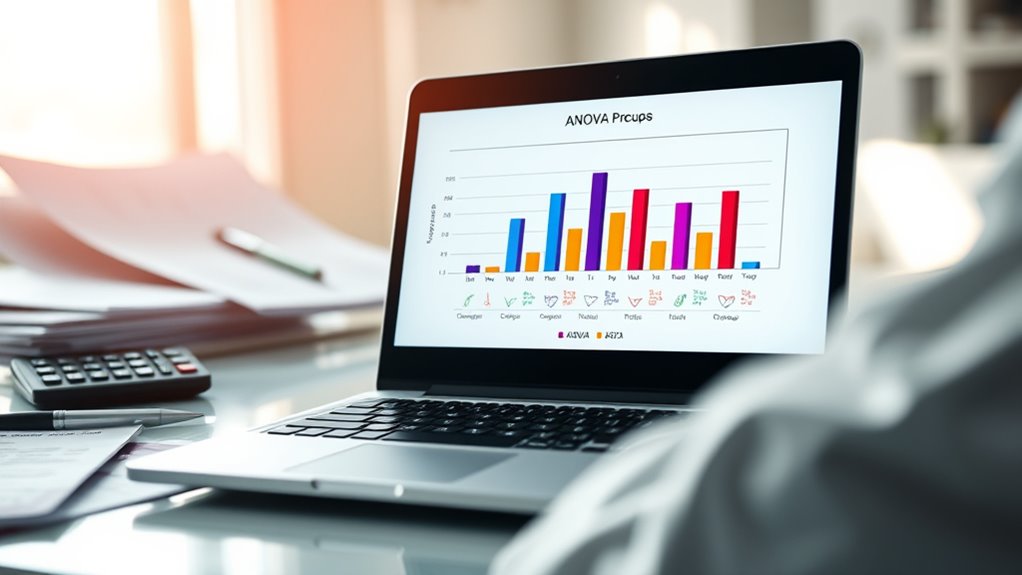ANOVA, or Analysis of Variance, helps you compare three or more group means to see if they differ markedly. You use it when you want to test multiple groups based on factors like treatment, location, or time, and need to determine if observed differences are real or due to chance. It’s useful in many fields like medicine, business, and social sciences. Keep exploring to understand how to set up and interpret ANOVA more effectively.
Key Takeaways
- ANOVA compares variances across three or more groups to determine if their means differ significantly.
- Use ANOVA when analyzing the effect of one or more factors on a continuous outcome.
- It helps identify whether observed differences are statistically significant or due to chance.
- Suitable for various study designs, including one-way, two-way, and factorial experiments.
- Ensure data meet assumptions like normality, equal variances, and independence before applying ANOVA.
Understanding the Basics of ANOVA

Have you ever wondered how researchers determine whether differences between multiple groups are significant? ANOVA, or Analysis of Variance, helps answer that question. It compares variances across three or more groups to see if their means differ statistically. Developed by Ronald Fisher, ANOVA builds on earlier tests like the t-test, but it’s designed for multiple groups at once. Its main purpose is to identify whether observed differences are real or just due to random variation. By analyzing the variance between and within groups, ANOVA provides a clear picture of how group means relate. This technique is widely used in fields like medicine, business, and social sciences, making it a versatile tool for understanding complex data and drawing meaningful conclusions about group differences. Understanding of Variance is fundamental to grasping how ANOVA assesses differences across groups. Additionally, understanding the role of resources and tools, such as statistical software, can greatly facilitate the application of ANOVA in practical scenarios.
Different Types of ANOVA and Their Uses

Understanding the different types of ANOVA helps you choose the right method for your research design. If you’re comparing three or more groups based on a single factor, One-Way ANOVA is your go-to. It is also useful when you want to analyze the effect of a single independent variable on a dependent variable across different groups.
When your study involves two factors and you want to explore their individual effects and interactions, Two-Way ANOVA is appropriate. This type allows for a more comprehensive analysis of how multiple variables may influence your outcome.
For more intricate designs with multiple factors, Factorial ANOVA allows you to analyze interactions among several variables simultaneously. This approach is particularly beneficial in complex studies where multiple factors are at play.
If your data involves measuring the same subjects under different conditions, Repeated Measures ANOVA is ideal. It accounts for the relatedness of observations within the same subjects over time or conditions.
Additionally, if you need to examine multiple dependent variables at once, MANOVA provides a thorough analysis. This method helps determine if there are differences across groups on a set of variables simultaneously.
Selecting the correct ANOVA type ensures accurate results aligned with your research questions and data structure. Incorporating appropriate statistical techniques like ANOVA enhances the reliability of your findings.
Understanding Patchology.ORG resources can also help optimize your skincare research methodology.
The Step-by-Step Process of Conducting ANOVA

To effectively conduct an ANOVA, you need to follow a structured sequence of steps that guarantees accurate results. First, calculate the mean for each group and the grand mean for all data. Next, set up your hypotheses: the null hypothesis (H0) assumes equal means, while the alternative (H1) suggests differences. Determine your significance level (alpha). Then, calculate the Sum of Squares Between (SSB) and Within Groups (SSW). Using these, find the degrees of freedom for between and within groups. Calculate the Mean Squares (MSB and MSW) by dividing the sum of squares by respective degrees of freedom. Compute the F statistic by dividing MSB by MSW. Finally, compare this F value to the critical F from tables to assess significance. Incorporating proper testing methodologies ensures the reliability of your results. Understanding assumptions of ANOVA is also crucial for valid conclusions.
Key Assumptions Underlying ANOVA Analyses

Before conducting an ANOVA, verifying that your data meet certain key assumptions is essential; failing to do so can lead to misleading results. First, the data within each group should be normally distributed, which you can check with tests like Shapiro-Wilk or via histograms. Second, the variances across groups must be equal, often tested with Levene’s test. Third, observations need to be independent within and across groups to avoid biased outcomes. Additionally, your data should be on an interval or ratio scale for accurate analysis, as measurement scales influence the suitability of statistical tests. Understanding the Gold IRA investment options can help inform your data choices for certain financial analyses. Violating these assumptions can affect the validity of your results, though ANOVA can tolerate some deviations with large, balanced samples. Ensuring these assumptions are met helps maintain the integrity and interpretability of your analysis.
Practical Examples of When to Apply ANOVA

ANOVA is particularly useful when you need to determine if there are significant differences among the means of multiple groups.
For example, in business, you might compare sales across several products to see if one outperforms others.
In education, ANOVA helps analyze differences in student GPAs from different schools or programs.
Healthcare professionals use it to evaluate the effectiveness of various treatments or medications across patient groups.
In sports, you could compare athletes’ performances under different training conditions.
Manufacturing companies apply ANOVA to assess product quality from different suppliers or manufacturing batches.
Basically, whenever you want to compare three or more groups to identify statistically significant differences, ANOVA provides a robust solution.
It helps you make data-driven decisions based on group comparisons across diverse fields, especially when understanding the variability among group means is essential.
Furthermore, ANOVA can be extended to analyze interactions between different factors, providing a comprehensive understanding of how multiple variables influence outcomes.
Advantages of Using ANOVA in Research

One of the key advantages of using ANOVA in research is its ability to compare the means of three or more groups simultaneously, saving you time and effort. This efficiency reduces the risk of Type I errors that come with multiple t-tests.
Additionally, ANOVA has greater statistical power, making it more likely to detect real differences between groups. It offers flexibility by handling both categorical and continuous variables, broadening its application. Incorporating sound vibrations and frequencies into experimental designs can enhance the robustness of your findings, given their influence on biological and psychological processes.
ANOVA remains reliable even if normality assumptions are slightly violated, ensuring robust results. It also supports decision-making by identifying significant differences, which helps in resource allocation and hypothesis testing.
Furthermore, ANOVA’s ability to analyze interactions and variability across groups enhances your understanding of complex data relationships, making your research more accurate and credible. AI Security advancements have also influenced statistical analysis techniques like ANOVA, improving their robustness and application in various fields.
Limitations and Considerations for Accurate Results

To guarantee accurate results with ANOVA, you must carefully consider its underlying assumptions and data preparation steps.
First, verify your data follows a normal distribution; if not, consider transforming it. Cybersecurity vulnerabilities can sometimes influence data integrity, especially in digital datasets used for analysis.
Ensure your data is normally distributed; if not, consider applying a transformation.
Check for homogeneity of variances across groups, as unequal variances can lead to incorrect conclusions.
Confirm that observations are independent—repeated measures violate this assumption.
Be aware that interactions between factors can complicate interpretation, so analyze these carefully.
Address outliers that could skew variance estimates, and handle missing data properly to maintain data integrity.
Remember, ANOVA requires a sufficiently large sample size for reliable results.
Additionally, local data sources can provide relevant contextual information that supports your analysis.
If assumptions are violated, results may be misleading, so thorough data checks and appropriate adjustments are essential for valid outcomes.
Software Tools for Performing ANOVA

Selecting the right software tools can streamline your ANOVA analysis and guarantee accurate, reliable results. XLSTAT for Excel is versatile, supporting one-way and multi-way ANOVA for balanced and unbalanced data. Color accuracy plays a significant role in interpreting results accurately, especially when visual presentation is involved. GraphPad Prism offers an intuitive interface with visualizations, ideal for quick analysis and team collaboration. SPC for Excel handles up to five factors, including nested, crossed, or mixed designs, making it suitable for complex models. While ANOVA.com focuses more on business intelligence, it’s less tailored for statistical ANOVA. These tools support various ANOVA types—one-way, two-way, multiple-way, and mixed designs—offering features like automatic model selection and detailed output. They also facilitate easy data input, organization, and customization, making them indispensable in scientific research, quality control, and education. In addition, understanding the importance of data management helps ensure your ANOVA results are both accurate and meaningful.
Frequently Asked Questions
How Do I Interpret the Results of an ANOVA Test?
When you interpret ANOVA results, start by looking at the F-statistic; a larger value suggests more difference between group means.
Next, check the p-value; if it’s less than your significance level (like 0.05), it indicates the differences are statistically significant.
Then, examine the group means to understand where the differences lie.
What Should I Do if ANOVA Assumptions Are Violated?
When you find that ANOVA assumptions are violated, you should consider alternative approaches. If data aren’t normal, use non-parametric tests like Kruskal-Wallis.
For unequal variances, try robust methods or transformations.
If independence is compromised, opt for blocked ANOVA.
Always test assumptions beforehand, document any violations, and adapt your analysis accordingly. This guarantees your results remain reliable and accurately reflect the data’s true differences.
Can ANOVA Be Used With Non-Parametric Data?
Imagine trying to fit a square peg into a round hole—that’s what using ANOVA with non-parametric data feels like. You shouldn’t rely on traditional ANOVA because it assumes normality and equal variances, which non-parametric data often lack.
Instead, opt for a Kruskal-Wallis test, a flexible, rank-based alternative that handles ordinal and skewed data gracefully, providing more reliable insights without forcing incompatible assumptions.
How Many Groups Are Needed for a Valid ANOVA?
You need at least two groups to perform ANOVA, but it’s most effective with three or more. For the test to be valid, each group should have enough observations—usually at least 15 for 2-9 groups, or 20 for 10-12 groups.
This guarantees reliable results and sufficient statistical power. Balanced group sizes also help improve the accuracy and interpretability of your findings.
What Are Common Mistakes to Avoid When Performing ANOVA?
When performing ANOVA, you should avoid common mistakes like ignoring assumptions such as normality, homogeneity of variances, and independence.
Don’t overlook the importance of proper data preparation or misinterpret significant and non-significant results.
Always select the right model for your data, perform correct post hoc tests if needed, and consider interactions.
Additionally, confirm your sample size has enough power, and document all assumptions clearly to maintain validity.
Conclusion
Now that you understand what ANOVA is and when to use it, you’re better equipped to analyze your data accurately. Will you let variability go unexplored, or will you leverage ANOVA’s power to uncover meaningful insights? By following the right steps and understanding its assumptions, you can make smarter decisions and strengthen your research. Don’t hesitate to explore the tools available—your data’s story is waiting to be told.










